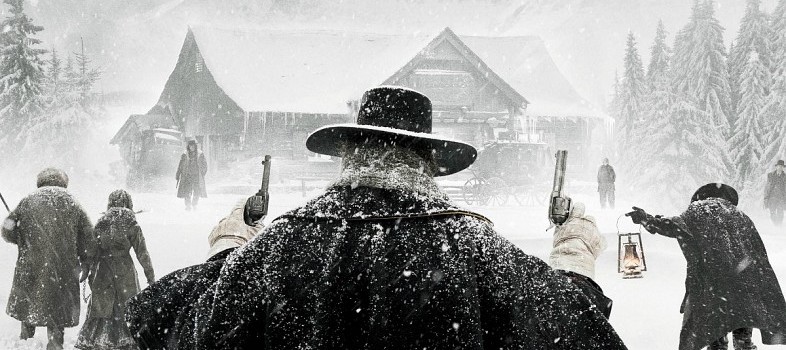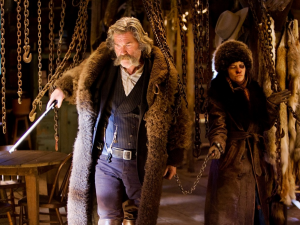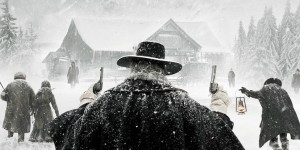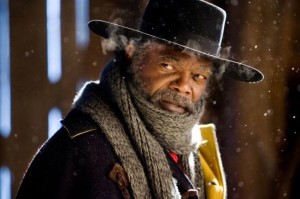The eighth film from Quentin Tarantino, The Hateful Eight, almost didn’t happen. Earlier in 2015 the script for the film, written by Tarantino, was leaked and the auteur was so upset that the surprises contained in his latest violence soaked tale would be ruined for his audience, that he threatened to walk away from the project and tackle something else. Thank goodness he didn’t and his latest is in theaters now.
The Hateful Eight is an old fashioned western that takes us back to the early days of the genre in many ways. There’s an overture, made even more brilliant in that it recalls Ennio Morricone’s classic spaghetti western soundtracks, yet still charters new sonic territory that is firmly Tarnatino’s. There’s an intermission midway through the three-plus hour epic and, most importantly, Tarantino shot the film in stunning 70mm giving us the scope and breadth of a cinematic experience that fits the landscape, the story and most of all the filmmaker himself.
In hindsight, The Hateful Eight plot is quite simple. Kurt Russell is John Ruth, aka The Hangman. He is bringing Jennifer Jason Leigh’s Daisy Domergue to Red Rock to hang in a stagecoach that is trying to outrun a blizzard that threatens to leave them stranded. After a glorious long establishing shot of them galloping across the snowy landscape, they come upon a fellow bounty hunter, Major Marquis Warren (Samuel. L. Jackson). He is in desperate need of a ride and after a classic Tarantino discussion, Warren hops in and the three head off towards Red Rock (with Warren’s dead bounties tied to the roof).
When it becomes clear they won’t outrun the storm, they stop into Minnie’s Haberdashery for shelter, an outpost between here and there that we get the impression both Ruth and Warren are familiar with. Inside the warm and toasty log cabin is a group of men who are an unknown. Ruth makes it clear from the get go that even though they may be stuck inside for days on end, he will not be kept from his mission of bringing Domergue to hang in Red Rock and the $10,000 that is his for doing so.
And such begins our mystery that in many ways has Tarantino crafting his first who-done-it and who-are-they of his career. Being stuck in one location may seem like it would be a limiting landscape for some filmmakers, but for the veteran, it is an explosive means to an ends. In many ways, The Hateful Eight is a post-Civil War Murder on the Orient Express that also explores race relations that are as pertinent today as they were in the “six or twelve years after the civil war” that this story takes place.
Clearly everyone in the Haberdashery are not who they say they are. And of all the characters that could crack this code, the one who does is a wholehearted surprise. And that’s just one of the shocks and awes that occur in Tarantino’s script. That’s why we’re thrilled he still pursued making The Hateful Eight. Tarantino could have walked away, but he had faith that his audience wanted to see his latest and could ignore the temptation to read the screenplay online in favor of waiting for the goods to unfold in the majesty of 70mm of the big screen. And it is a marvel, visually, dramatically, verbally, violently and in all forms, cinematically.
Tarnatino’s ensemble lives up to his past troupes and in many ways does more with less. Bruce Dern is a fantastic addition and Walter Goggins is so purely QT material that we suspect he’ll be making multiple appearances in the filmmaker’s upcoming work, like Russell, Jackson, Roth and Michael Madsen do here.
The standout here is Jackson. He deserves an Oscar nod for the range of emotions and the pitch perfect tone he elicits as the post-slavery embodiment of America that his character represents. It is a stunning piece of work and easily the crowning achievement for the veteran actor… not that he is even remotely close to calling it quits.
From a filmmaking standpoint, Tarantino is at the top of his game. From his establishing shots to the slow boil of suspense he shrouds his film in for just over three hours. Sure, it’s violent, but that violence doesn’t really emerge full force until late in the third act… which is rare for him. The audience knows that the guns will start shooting bullets all over, but the question (and the suspense therein) is when. We never know. The audience simply is aware that this is a story about violent people who do violent things and when that violent nature turns to action — that is another layer in this mystery.
The Hateful Eight, even at over three hours, is the type of film that we want to see again and again. There is so much richness to the painting that each stroke can be seen in a different light with subsequent viewings. It’s also fascinating that this is a western that feels modern. That is no easy task and is another example that we have a filmmaker in Tarantino that is worth putting his name above the marquee. Simply his moniker alone sells the audience. After The Hateful Eight has had a chance to fade into history, that fact is only fermented further.
Needless to say, it’s a slam dunk to make our top 15 of 2015.
Grade: A




